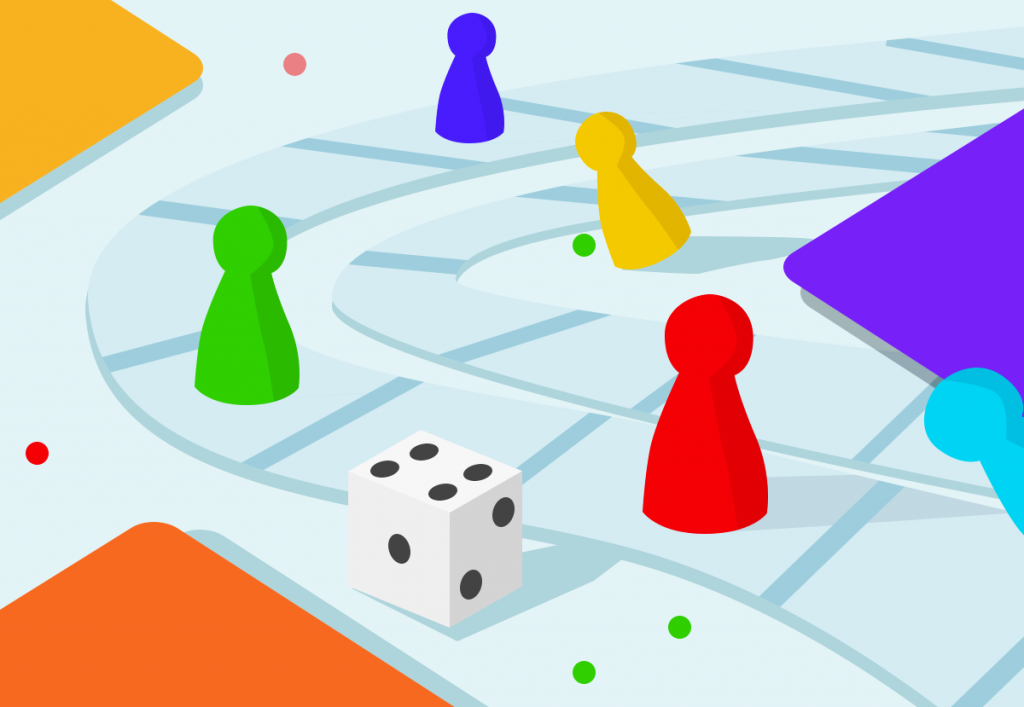51 best employee team building games for improving productivity at work

Team building games are often met with a groan. Nobody wants to spend time doing awkward activities with coworkers, especially so if it feels pressured.
But the thing is – team building doesn’t have to be boring or unpleasant. The right team building activities can help your employees bond, which in turn boosts engagement and productivity.
Want to get the most out of your time?
Try DeskTime for free!
Try free for 14 days · No credit card required.
By signing up, you agree to our terms and privacy policy.

Why team building?
Gallup’s State of the American Workplace survey reveals that companies with engaged employees are more productive. In fact, the top 25% have significantly higher productivity, profitability, and customer ratings, and less turnover and absenteeism than companies in the bottom 25%.
But how do you increase engagement at the workplace when 70% of the American workforce reports feeling “not engaged” or “actively disengaged”?
This is where team building comes in. Creating opportunities where your staff can get to know each other outside of a strictly professional setting can help break the ice and build a strong bond between coworkers.
After all, according to Gallup, having a close friend at work boosts engagement by 50%, and those with a best friend at the office are 7 times more likely to be fully engaged in what they do.
The right team building games can also:
- Improve communication
- Encourage teamwork
- Reveal your team’s strengths and weaknesses
- Boost creativity
- Build confidence in your employees
For the most part, team building activities for work can be divided into two main categories – team building games indoors and team building activities for outdoors.
Note: is your team working remotely? Then team building activities are more important than ever! Check out these 17 games & activities perfect for remote teams!
All that’s left for you to do is – pick any of the 51 best employee team building games that feel natural, let your employees open up at their own pace, and watch the fun unravel!
Employee team building games to try indoors
1. What’s my name?

“What’s my name?” is an excellent ice-breaker team building game where players use “yes” or “no” questions to guess the identity of a person.
Number of players: This team building game is suitable for just about any size group.
How to play: Each player writes the name of a person on a self-sticking name tag. The person can be anyone – a celebrity, an iconic person, a famous athlete, even a client of your company. The players then place the name tag on the back of another player so they can’t see who they are, but the rest of the group can.
While mixing and mingling, each employee will ask the others various “yes” or “no” questions to help them figure out who they are supposed to be. Once they’ve guessed the name of the person, they can remove the tag.
Why play? The employees will warm up and get talking to each other, improving communication skills.
2. Office trivia game
Fun trivia games are not just something played in that “Friends” episode. This team building activity will test your team’s workplace knowledge and break the ice at any employee get-together.
Number of players: This game fits groups of all sizes and can be played individually, in pairs, or in teams of 3-6 people.
How to play: Create a list of trivia questions regarding your workplace and see which team gets the most correct answers. You can type a document of the questions leaving an area blank for the answers or do a live quiz where you read out the questions and the first one with the correct answer gets the point. The team (or employee) that gets the most answers correct wins the game.
Why play? This team building game improves problem-solving, knowledge about your office culture, and is just plain fun!
3. No smiling
This team building energizer is meant to get a laugh out of even the most serious teams and can re-engage the team in a stressful situation.
Number of players: Fits all group sizes, but the more – the merrier.
How to play: Before starting a meeting or party, ask everyone to sit down and tell your employees they’re not allowed to smile for a couple of minutes. See who can last the longest.
Why play? A great method of creating a bit of fun and lightening the mood of any event or even a meeting.
4. Ultimate dinner party

It’s actually a common question – if you could invite anyone to have dinner with you, who would you invite? Bill Gates, Michelle Obama, or Lady Gaga? Turn this question into a team building activity, and you’ll be surprised by the answers you hear.
Number of players: Groups of all sizes.
How to play: Have everyone answer the question “If you could invite any 3 people (living or deceased) to a dinner party, who would you invite”. Each participant takes a turn in telling their ultimate dinner party scenario and explains why he or she picked the people involved.
Why play? The employees will open up to each other and find out more about their coworkers.
5. Back-to-back drawing
Back-to-back drawing is a creative communication team game for office that will get your employees working and talking together, as well as turn everyone into promising Picassos and Signacs.
Number of players: Ideally 6-16.
How to play: Split your employees into teams of two and have them sit back to back. In this game, one person will be “the listener”, while the other one will be “the speaker”.
The team’s speaker has a picture of any kind, while the listener has a piece of paper and a pencil. The speaker then describes to the other person what the picture looks like without using words that give away exactly what it is. The listener tries to draw that picture with the clues given.
Why play? This is one of those team building activities that focuses on improving verbal communication and listening skills. It’s surprising to see how differently participants interpret instructions when they’re supposedly talking about the same thing.
6. The barter puzzle
Jigsaw puzzles aren’t just fun – they improve problem-solving skills, attention, and harness brainpower. By playing the jigsaw barter puzzle, your team will have to make decisions under pressure and get to collaborate as a team.
Number of players: Preferably 12-20 players divided into teams of 4-5.
How to play: Split your team into groups with an equal number of members. Each team gets a distinctly different jigsaw puzzle of equal difficulty. They have to complete the puzzle within a set amount of time.
The extra trick here is that some of the pieces from their puzzle will be in another team’s pile.
The goal for each team is to complete their puzzle before the other groups. Besides, they must convince the other teams to give the missing pieces back – either through barter, negotiation, exchange of team members, donating time to another team, etc.
Why play? The barter puzzle promotes discussion and interaction as teamwork is essential for finishing the job. In addition to that, this team building game brings out the best negotiators and strategizers in your employees.
7. Karaoke

Did you know that singing is the best team building exercise out there and allows colleagues to bond with each other faster and more effectively than the typical ice-breakers? Let loose and give others a glimpse of the real Rolling Stones-loving you!
Number of players: Unlimited.
How to play: Your team can all go out to a karaoke bar or sing karaoke in the office with the help of karaoke games like Smule. While there are no set rules to karaoke, keep in mind that it’s best to pick songs that speak to every generation. Also, while you should definitely let your talents show, try to avoid showing off too much.
Why play? A great team building activity that helps coworkers get to know each other and bond.
8. Two truths and a lie
This is a simple, yet effective team building game for the participants to get to know each other in an informal setting. The game works best in a small informal dinner or a large conference room.
Number of players: 5-100+ participants.
How to play: Each player must announce two facts about themselves that the rest of the group doesn’t know. The players must also come up with a convincing lie. The other participants will then ask questions in order to determine which are the two real facts and which is the lie. Make the game more fun by coming up with facts and lies as extravagant as possible!
Why play? This team building game encourages the players to open up to each other and see their teammates in a completely different way.
9. Count to 20
In this quick improv team building activity, your employees will count to 20 to practice active listening, teamwork, and forward-thinking. Sound too easy? Give it a try!
Number of players: 5-30 participants.
How to play: Divide the players into smaller groups and have each one stand in a circle. The alternative would be to have one large circle for a smaller number of players. All participants are looking at the ground with closed eyes. The goal of the exercise is to count to 20 as a team.
The challenge here is that there’s no way of knowing who will speak each number, and if two or more people speak at once, the entire group starts back at one.
Once starting this activity, somebody in the group has to take a leap and start the game by saying “one.” The next person would continue with “two” and so on until you get to 20 as a team.
Why play? “Count to 20” is the type of indoor team building games for employees that encourages teamwork, collaboration, and active listening.
10. Battle of the airbands

Not really into karaoke? The battle of the airbands is the next best thing and will reveal your team’s hidden rockstars.
Number of players: 20-60 people.
How to play: Split your team into groups of three or four people. Have them pick a band name, a song and do their best impression of performing it with air instruments and lip-syncing. Props and costumes are always a welcome addition to the performance! In order to be objective, select a group of judges from the teams to pick a winner.
Why play? This music-based activity is a great alternative for team building games for employees indoor. It enables your team to step into the spotlight and promotes team bonding.
11. Follow the leader
This is one of those team building activities that will require your entire team to work together as one and follow a secret leader who will make simple movements for the entire group to mimic. Another person – the guesser – will have to determine who’s the leader of the pack.
Number of players: 8-80 people.
How to play: One person from the group is chosen as the guesser and briefly leaves the room. While the guesser is gone, the group elects one person to be the leader. This person will make movements that the followers can quickly mimic (scratch their head, jump on one foot, pat their stomach, etc.). When the guesser comes back in the room, he or she will try to discover who’s the leader by watching the movements of the group.
Why play? Improves non-verbal communication, cooperation skills, builds trust and team cohesion, as well as leadership.
12. Under 18
This super easy team building game will take your employees back to the time when they were just kids and teenagers. What were their accomplishments at the time? Who was the local spelling bee champion and who broke records in track? Find out!
Number of players: Any number of players.
How to play: Ask your employees to share their biggest accomplishment that occurred before they turned 18.
Why play? This game will reveal a little more about your employees and get them to open up.
13. Escape room quests

Get your team out of the office (but still managing to stay indoors) for an escape quest – a live action game where the team works together in order to find an exit by solving riddles and puzzles.
Number of players: Depends on the quest, usually up to 10 people per game.
How to play: Your team will be given a mission and placed into a themed room. In there, you must explore to find hints and clues to ultimately free yourself. This can be anything – from containers with passwords to locks needing a key.
If your company is large in numbers, split up into several groups and have each team try a different quest.
Why play? Great team building activities are all about teamwork and problem solving under pressure, and that’s exactly what escape room quests promote. By solving puzzles and riddles together, coworkers build a stronger bond and start feeling more comfortable around each other.
14. Murder mystery dinner party
In murder mystery games, one of the dinner guests is secretly playing a murderer, while the other attendees must determine who among them is the criminal.
Number of players: Best for 6-28 participants.
How to play: Choose a theme for your company’s murder mystery – pick any one of these free scenarios. Have everyone dress up according to the theme and bring a dish to the location of the mystery dinner party (this can be the company’s office).
The dinner party then follows the instructions on your chosen murder mystery scenario, passing out name tags, maps, suspect dossier files, and more. Have the employees work together and solve who’s the mystery criminal.
Why play? This fully immersive team building game improves critical thinking skills, boosts teamwork, and is simply very fun.
15. PowerPoint karaoke
In this improvisational team building game (also called PowerPoint roulette or Battledecks), each person presents a slideshow to an audience without knowing the contents of the slides.
Number of players: Starting from 3 and up to 20 if playing in teams.
How to play: Each player gets a set of pre-prepared PowerPoint slides they haven’t seen before. Based on the slides, the players give presentations to a live audience – their coworkers. To see which presentation wins, have the audience applaud for each presenter once all the presentations are done. The name that has the loudest cheer is proclaimed the winner.
Why play? This team building activity tests presentation and improvisation skills, and will easily get people laughing.
16. Charades

You probably played charades as a kid or in parties, but this old-school game can also be used in a workplace setting for enjoyable team building.
Number of players: 6 players or more
How to play: Before beginning the game, pick several categories like Movies, Bands, Cartoon Characters and so on. Write them on separate envelopes. Think of about 5-6 items or words for each category and write them down on a small piece of paper, then put them in the particular envelope. For example, under bands, you could put The Beatles, Spice Girls, The Kooks and so on.
Separate people into two teams. Each team will take a turn and send out a representative to act out the items in the category of his or her picking. The actor cannot speak or draw any words, while the others in the group try to guess the item. If the group guesses the name of the item, they get a point for each right answer. The team with the highest score wins.
Why play? This team building game can help build team camaraderie through lots of acting.

Keep Your Employees Happy!
Use DeskTime’s powerful features to maintain a healthy work-life balance while boosting productivity.
17. Video gaming tournament
If you think video games are just about fun, think again. They’ve also been shown to be good for brain health, increasing focus, and boosting productivity. Even if you’re not a fan of playing the games, you can just listen to their soundtrack – a proven method that stimulates the brain and keeps people energized at work.
Number of players: 1-10 participants.
How to play: Start by getting a video gaming console for the office to show you’re embracing the gaming culture. Create your own small collection of video games focusing on the ones that require coordination between players – like Halo, Rock Band, or Just Dance for an added physical activity bonus.
The next step would be trying to introduce a video gaming break once a week or organizing a video gaming tournament after work hours.
Why play? Engaging and stimulating, video games are proven to boost business morale and improve productivity even in adults.
18. Googly eyes
This fun drawing-based game will make a great addition to the next board gaming night at the office. Googly Eyes is similar to Pictionary and requires you to draw, but comes with a silly twist – you have to wear goggles.
Number of players: 4-16 participants.
How to play: Players are required to get to the finish first by winning the drawing challenges. Each player wears goggles that blur their vision while guessing what their teammate is drawing. What’s useful is that the googly glasses fit all ages and fit over prescription glasses, so it’s perfect if the company is having a “bring-your-kid-to-work” day.
Why play? This game is easy to learn, yet it will bring your team lots of laughs.
19. Code of conduct

A simple, yet meaningful team building game that will set the tone for the event and build consensus on shared values. In this activity, teams list what matters to them on a whiteboard.
Number of players: 10-30 participants.
How to play: On a whiteboard, write down the words “meaningful” and “pleasant”. Each participant tells the group what makes this event or seminar meaningful or pleasant. For each suggestion, make sure all participants understand the idea and there’s the consensus from all participants.
Then, go through each suggested idea and ask how the participants would ensure it’s carried out. Record the notes on the whiteboard with sticky notes.
Eventually, all ideas mutually agreed on as being “meaningful” and “pleasant” will create the Code of Conduct for the group, and they have to uphold their code throughout the event.
Why play?
The activity builds mutual trust and establishes group values. Perfect for the start of an event, seminar, or a workshop.
20. Silver lining
Going down the memory lane is a great way to get team members to bond with each other. However, not everyone will recall an event in the same light as others. Pointing out the silver lining will help people see things from their coworkers’ perspectives.
Number of players: 4-12 people, divided up into pairs.
How to play: Divide all participants into teams of two or more people based on who’s had a shared work experience – for example, working on the same project.
One team member shares a negative experience from that experience, while the other team member shares the same experience, but focuses on the positive aspects of it. This is where the “silver lining” is revealed. Then they switch, the latter telling a negative memory, while the former tells a positive one to counteract it.
Why play? This team building activity reframes experiences, improves morale, and shifts perspectives.
21. Odd couples
In any given team, you’ll have different personalities working together. This team building activity will let people appreciate their differences, and at the same time find something in common to improve team bonding.
Number of players: 6-20 participants.
How to play: Create a list of odd pairs of objects that go well together – salt and pepper, Sonny and Cher, John Lennon and Yoko Ono, peanut butter and jelly, etc. Write down the objects on separate pieces of paper.
Tape the papers to participants’ backs. The participants then mingle with the group. The objective is to figure out what’s written on their backs by asking only yes or no questions.
When the players have figured out what they are, they have to find the other half of their odd pair. When they’ve found their pair, the participants have to find three things they share in common.
Why play? Improves team bonding and communication skills, gives the chance to mingle with people you wouldn’t communicate otherwise.
22. Birthday line-up

A simple team building game that will get people to communicate through body-language.
Number of players: Ideally 8-12 participants.
How to play: The group stands in a straight line side by side. The goal is for the participants to organize themselves in order by their birthday (month and day) without any talking. If they do start to talk, they need to start from the beginning. If you want to add an extra challenge to this activity, try blindfolding a couple of participants.
Why play? Practices problem solving, cooperation and non-verbal communication skills.
23. Lights, camera, action!
Whoever doesn’t love movies? Have the team stretch their creativity and communication skills by having them plan, script, direct, and perform their very own cinematic masterpiece.
Number of players: 8-40 participants.
How to play: Disclaimer: you will need specific equipment for this team building activity (cameras or smartphones with decent inbuilt cameras, tripods, computers with video editing software, TV).
Split the participants into smaller teams – each of them will create their own movie. Each team picks a mystery envelope containing a film genre or theme. The final cut of each movie will need to reflect the genre.
Set a deadline for each final cut for the film premiere (normally 4-6 hours after you begin the exercise). Now, the production starts! Each team member should have a specific role – the director, the producer, video editor, actors, etc.
At the end of the activity, all the films are watched, and the best ones receive awards. Popcorn and drinks for the final screening will be a nice touch!
Why play? A team building activity that’s highly entertaining and rewarding, as well as boosts creativity.
24. Improving self-esteem
How often do we stop to compliment our coworkers on a daily basis? Probably – not often enough. Improving self-esteem is a team building activity that will boost confidence in your team.
Number of players: Unlimited.
How to play: Everyone writes down their name on the top of a piece of paper. They pass the paper to the person on their left. Each person must then write something they admire about the person whose name is on the top of the page. This can be anything – from their personality, looks, something they’ve managed to achieve, etc. The papers are passed around to the left until each sheet ends up back with the person named on the top.
Why play? Boosts confidence, lets coworkers know they’re appreciated by their teammates.
25. Shark tank

“Shark tank” is a team building activity that’s based on the eponymous TV show. The goal is for teams to pitch mock products in front of a group of “sharks” to secure investments.
Number of players: Preferably up to 24 people split into teams of 2-6 players.
How to play: Participants are divided into teams of 2-6 people. Each team has to come up with an imaginary product and develop a pitch for it. The pitch must include a brand name, slogan, business plan, marketing plan, financial data.
Meanwhile, choose 3-4 people to be the “sharks” who will evaluate the pitches. Give them an imaginary pool of money they can invest in the pitched ideas, as well as provide an imaginary background for each of the sharks (for example, “X is the second cousin of Kim Kardashian, the secret mastermind behind her cosmetics empire”).
Each team then presents their pitch in front of the sharks. The sharks must ask questions and evaluate the pitches as if they were real businesses. The team that gets the most investment wins.
Why play? This team building activity promotes unconventional thinking, collaboration, entrepreneurship, and teamwork.
26. Memory wall
One of those team building games indoors that establishes and re-lives the team’s memories. Participants sketch their shared work memories and place them on a memory wall to create a welcoming environment and reaffirm a positive work relationship with other employees.
Number of players: 6-50 participants.
How to play: Each player writes down positive memories of shared experiences and moments on a sheet of paper. They then draw a few of these memories on fresh sheets of paper. The participants tape their memory drawings to the memory wall, while other participants approach the wall to expand on the memories with additional drawings.
Why play? Builds camaraderie between team members and fosters relationships.
Team building activities for outdoors
27. Minefield
Navigating an obstacle course, but with your eyes closed – it might seem tricky, but it’s doable when you have the right peer to guide you.
Number of players: Groups of any size.
How to play: Divide the group of people into pairs and have one person of each pair blindfolded. Lay out objects in random pattern creating a sort of “minefield” (best to do this prior to starting the game). Make sure to mark the start and finish line.
Have the unblindfolded person lead their partner through the obstacle course using verbal guidance only. The goal is for the blindfolded person to make it out on the other side without having touched any of the objects. The first person to cross the finish line wins.
Why play? Exercises effective communication and trust.
28. Egg drop

This is one of those fun team building activities for outdoors where players get to practice creative thinking and problem-solving. The purpose of the game is to build a structure that prevents an egg from breaking.
Number of players: 6-50 players.
How to play: Assemble groups of three to five people and give each team various materials for building (paper straws, a roll of masking tape, one fresh egg, newspapers, etc.). In a set amount of time (for example, 15 minutes), each team has to complete building a structure, with the egg inside.
When time expires, all structures are collected, and a judge tosses them from at least 10 feet in elevation. The structures are then inspected to see if the eggs survived. The winners are the groups that successfully protected the egg.
Why play? Boosts teamwork, creativity, problem-solving, and time management.
29. Scavenger hunt
Although this team building activity requires a lot of preparation, it is a timeless classic that works in any situation, location, or team size. You can run it indoors as well, although being outdoors will give your employees a much-appreciated change of scenery and pace.
Number of players: Unlimited.
How to play: Create a list of activities and align them with the purpose of the hunt. If you want new employees to connect with senior employees, design team-focused activities that will force them to collaborate.
Assign a point system for each activity, based on the difficulty level. Divide the group into equally-sized teams. Leave 60-90 minutes for the actual hunt. Once the time is up, evaluate which team completed the most activities and has the highest points.
Why play? A team building activity outdoor that inspires collaboration, problem solving, teamwork, and is very fun.
30. Lasertag
Laser tag is a recreational team sport where players attempt to score points by shooting infrared-sensitive targets usually with an infrared-emitting targeting device. It is entirely safe and will provide a fun-filled bonding for the employees.
Number of players: 2-40 players.
How to play: You’ll need to book a local laser tag arena beforehand to play laser tag. Each player gets their laser tag gear and enters the arena. The players are usually divided up into two teams and they have to “tag” or “hit” their enemies with the beam of light shot by their gun. Employees will begin to work together to create new strategies in an attempt to win.
Why play? It’s entirely fun and requires a good level of communication, collaboration, and coordination. It will also get the team’s heart rates up as it requires a fair amount of running around.
31. Go-kart racing

Let your employees race around the track at up to 45 mph and experience the thrill and adrenaline of go-karting!
Number of players: Perfect for groups of 20 drivers.
How to play: Book a go-kart track beforehand. Upon arrival, all participants will be briefed on the safety procedures and details about racing and the go-karts. You can try a warm-up classification race and then do a Grand Prix with 10 laps and see who races to the finish first. Prepare a trophy or a prize for the winners.
Why play? Go-karting is easy to learn, fun, and thrilling. It will also introduce a bit of friendly competition among employees.
32. Group juggle
Since the game involves throwing balls, this quick team building activity is best for outdoors, although you can play it in the office as well. Great for playing at the beginning of any team event.
Number of players: Best for 10-20 players.
How to play: Have all players stand in a circle. One person (let’s say her name is Pam) starts off by saying: “I’m Pam”, passing the ball to someone else across the circle. The person who catches the ball says “Hi Pam, I’m Dwight.” Then Dwight passes the ball to the next person, following the same pattern. Increase the difficulty by increasing speed and the number of balls in the circle.
Why play? This activity breaks the ice, helps learn names, exercises memorization skills.
33. Ropes course
A ropes course is a team building activity outdoors that includes high (constructed in trees) and low (take place on the ground) elements. Rope courses are sometimes challenging on a personal level, as they may involve confronting fears and anxieties.
Number of players: Unlimited.
How to play: Book a rope course venue for this activity. A rope course usually includes obstacles like a 20-foot wall the participants must get over, a tightrope walk, as well as swinging ropes. Keep in mind the physical abilities of your team so that the course is not too difficult or too easy.
Why play? A great team building activity to test teamwork skills, determination, and patience. Explores leadership and communication concepts, as well as involves problem-solving.
34. River crossing

If you ever played “The floor is lava” in your childhood, you’ll enjoy this team building activity that requires group coordination. The aim is for all members of the group to cross “the river” without falling or touching the earth.
Number of players: 8-30 players.
How to play: Divide the players into two (or more) teams. The players must all cross the imaginary river by jumping and maneuvering different objects. Whoever touches the floor, gets burnt and must start the course from the beginning. The first team to get over the river with all team members are declared the winners.
Why play? This team building game tests coordination, promotes communication and teamwork.
35. Kickball
Instead of playing basketball, baseball, or soccer, where some people might have more experience than others, opt for kickball. In this team building activity, athleticism isn’t much of a factor, yet it will still be a viable and fun alternative that anyone can play.
Number of players: Kickball is usually played with teams of 5-15 people.
How to play: Kickball (also known as kick baseball) is similar to baseball in terms of field, rules, and scoring points. The main difference is that you kick the ball instead of hitting it with a bat. The ball is also made out of rubber and is much larger than in baseball – closer to the size of a football in soccer. Eventually, you can even form your own company kickball league and play with other local businesses and form productive partnerships.
Why play? Kickball is growing in popularity, especially in the United States. It’s easy to learn and play, it allows the employees to socialize and exercise together.
36. GPS adventure
GPS-based team building games are great fun for the whole team and usually involve following clues to find hidden objects by using GPS coordinates.
Number of players: 2-100+ participants.
How to play: The employees are split into teams before the start of the race. Each group of teammates needs to have a GPS device on to help them with searching. The moderator of the GPS adventure sets a period of time in which all groups try to complete as many GPS puzzles as they can and must return to “base”.
Why play? The kind of team building activities for work that motivates employees to collaborate, promotes problem-solving and will make them feel as if on an Indiana Jones-like adventure mission.
37. Attend sporting events

Sometimes, an effective team building activity is just to kick back and relax – especially so if your company has been going through a demanding and busy period. So why not take the team out for an engaging sports game where the athletes do all of the work?
Number of players: Unlimited.
How it works: Do a survey to find out what kind of sporting event your employees would like to attend. A good idea is to pick an event where a local team or athlete participates. Don’t worry if not everyone is a sports fan – you don’t have to be obsessed with sports to appreciate the enthusiasm and happiness you can experience in a large-scale competition.
The result? Attending a sports event is the perfect way to get your mind off things and will help employees to socialize in a relaxed atmosphere.
38. Blindfold square
This quick team building game will get small and large teams to communicate when they can’t see one another or their progress.
Number of players: 4-50 participants.
How to play: Each player is blindfolded and positioned in the area where the game takes place. The challenge is to take a length of rope and lay it out on the ground to make a perfect square. Make sure the rope is long enough and be ready to intervene so that the players don’t hurt themselves.
Why play? Promotes communication, trust, and teamwork.
39. Body of words
This physical team building activity will engage the entire team and get people to relax and collaborate while also promoting leadership and planning.
Number of players: 4-24 players.
How to play: The goal of the game is for your team to create letters and words with their bodies alone. You need to have a wide open area without any obstacles. Divide participants into teams of 4-8 people and ask them to select a leader. Think of words that contain one letter less than the number of people in each team. For example, if there are 6 people per team, choose words like “apple”, “berry”, “Sansa”, etc. Write the words down on index cards.
Each team then picks a word at random, and they have to display the word with their bodies alone. The team that makes the word the fastest wins.
Why play? This team building game promotes planning, leadership, creative thinking, and cooperation.
40. Capture the flag

“Capture the flag” is a traditional outdoor game that’s been around for years – and for good reason. It’s simply a lot of fun! This team building game involves two teams, a flag, and lots of running.
Number of players: 8 or more (4-5 people per team).
How to play: Divide the players up in two teams. They will compete against each to try and find the other team’s flag. When the flag is located, they must try to bring it back to their home zone but have to avoid getting caught and tagged by the opposite team.
Why play? Promotes teamwork, planning, strategy, leadership. It also involves a great deal of running and is great is you have a large outdoor space.
41. 123 lookup
They say that a person’s eyes are the window to their soul. Well, have you looked into the souls of your teammates? This team building game will allow you to!
Number of players: Minimum 8 participants.
How to play: The group forms a circle, either sitting or standing. On the count of three, each member of the group has to look at someone else in the circle. If two people in the group look at each other, they are eliminated from the game.
Why play? This quick team building activity will get the participants to loosen up. A great game to play at the beginning of any event.
42. Golf
A golf-based team building activity provides positive reinforcement of teamwork and lets the employees build interpersonal relationships.
Number of players: 4-20 participants.
How to play: Book a location for your outing. Best golf locations for team building events are municipal golf courses or small private courses. When starting the activity, select the style of play. If skill levels vary among your team members, play Scramble as it will require team members to hit each shot. The players then decide which is the best shot and all team members hit the next shot from that spot.
The game continues until the ball is in the hole. In this type of golf play, each time the team hits the ball counts as 1 point. The team with the lowest total score wins.
Why play? Golf will get your employees out of the office into the fresh air, encourages communication, the competitive element of the activity increases motivation.
43. Beach Olympics

Beach Olympics is a collection of team building games and activities for outdoors where each team gets to play an individual game against each other. Beach Olympics is a great way for the whole team to unwind and get to know each other.
Number of players: 20-400 participants.
How to play: Pick a beachy location or book a Beach Olympics activity through an event planning agency that will plan all the activities. Beach Olympics usually include a mixture of passive and active games that allow each participant to contribute to their team’s overall performance. Some of the activities include beach relay races, volleyball, hula hoop hurl, sandcastle contest, and frisbee golf.
Why play? Beach Olympics provide the perfect opportunity for even larger corporate groups to get competitive with one another, get to know each other, and build the spirit of camaraderie.
44. Helium stick
This simple, yet powerful team building exercise is a great way of learning how to work together as a team and communicate in small to medium-sized groups in order to complete a shared goal.
Number of players: 6-40+ participants (6-9 people per team).
How to play: Organize your group into small groups. Take a dowel rod (as thin as possible) and hold it horizontally about chest height. The players need to hold the stick onto their index fingers and lower it to the ground as a team.
Why play? An effective ice-breaker activity that will help you make lots of conclusions about the level of verbal vs. non-verbal communication in your team. Improves leadership, collaboration, concentration, and creative thinking.
45. Welded ankles
This no-prop team building exercise requires a high degree of focus, integrity, and the whole team has to be in sync.
Number of players: 4-40+ participants.
How to play: Mark a straight line using bright paint or use a bright-colored rope. The team has to walk from start to finish, maintaining contact of the ankles. If anyone from the group loses contact, they have to start over. If you want to create extra limitations, let the participants know they must remain silent beside one or two of the players.
Why play? These types of team building activities promote communication, leadership skill, and boosts teamwork.
46. Survivor
Want to take team building to the next level? Create your own version of the popular TV show Survivor and put each member to the test in a refreshing and adrenaline-rushing team building outing.
Number of players: 20-240 participants.
How to play: The team is divided into teams – or tribes. Throughout Survivor, the teams are tested and challenged with a series of physical and problem-solving activities that are based on survival skills. The goal is for the teams to work together to save their teammates and keep them “on the island” or in the game. Since this team building activity is rather complex, it’s recommended to book it with an event agency which would tailor the activity’s program for your team.
Why play? In this team building activity, each challenge requires a different skill, so everyone gets an opportunity to shine.
47. Bubble soccer
This is one of those fun team building games that will have your team bouncing around with laughter – literally!
Number of players: 10 players divided into two teams (more people can play if you organize a tournament).
How to play: The recreational activity is similar to a regular soccer game – except each player is half-encased inside a giant bubble. The game is typically played in teams in large indoor spaces or outdoor fields. Bubble soccer follows the same objectives and overall rules as regular football – teams compete to hit a ball into the opposing team’s goal.
Why play? Develops skills like collaboration, communication, and strategic thinking.
48. Balloon in water
Be prepared to get wet! In this team building activity, the team has to immerse an inflated balloon underwater and hold it there for at least 5 seconds, using only the materials provided.
Number of players: Teams of 8-10 people (with a larger number of participants, divide them into smaller groups).
How to play: The teams are given 1 minute planning time, followed by 5 minutes to do the activity. When the team is ready to hold the balloon under water, they should notify the judge who will then judge if their balloon is submerged for the minimum of 5 seconds.
Why play? This team building activity encourages problem-solving, communication, and creative thinking.
49. The longest shadow

“The longest shadow” is an outdoor team building activity that will have the group working together. The goal of the game is for the team to form the longest shadow they can, using only their bodies.
Number of players: 10-20 participants.
How to play: The game starts with 5 minutes of planning time where each team cannot test out their plan but can only have a verbal discussion. Once the planning is over, they have 10 minutes to test and execute their plan to create the longest continuous shadow.
Why play? Promotes creativity, collaboration, and problem-solving.
50. All aboard!
This team building game will require team members to work together in close physical proximity in order to solve a practical and physical problem.
Number of players: 8-50+ participants.
How to play: The goal of the game is for the entire team to fit into a circle or square on the floor. After the group has successfully fitted into that shape, the object is made smaller. Each time all players fit into the object, it is then made smaller and smaller. At one point, team members will have to support each other and work as a team to finish the challenge.
Why play? This activity builds trust and patience, improves communication, leadership skills, and collaboration, and is a great game to have fun.
51. Geocaching adventure
Similarly to a scavenger hunt, a geocache adventure is based on clues but also involves using GPS coordinates.
Number of players: 4-100+ participants.
How to play: Create a list of geocaches the participants must find in a set time period. Each team uses a GPS device to locate the geocaches. The clues you hide in specific locations can be a part of a larger riddle the teams have to solve.
Why play? One of those team building activities for outdoors that will help team members work together to achieve a specific goal. Promotes problem-solving in a creative way.
Did you find this article useful? Give it a clap!
Psst! You can clap more than once if you really loved it 🙂